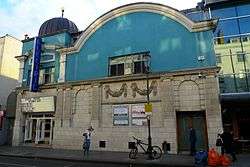Electric Cinema, Notting Hill
| Electric Screen, Imperial Playhouse Theatre, Electric Cinema Club | |
|
The Electric Cinema | |
| Address |
191 Portobello Road London United Kingdom |
|---|---|
| Coordinates | 51°30′56″N 0°12′18″W / 51.5155°N 0.2050°W |
| Operator | Soho House |
| Capacity | 83 |
| Current use | Cinema |
| Construction | |
| Opened | February 1910 |
| Closed | 1993 (re-opened in 2001) |
| Architect | Gerald Seymour Valentin |
| Website | |
| www.electriccinema.co.uk | |
The Electric Cinema is a movie theatre in Notting Hill, London, and is one of the oldest working cinemas in the country.
History
The Electric Cinema first opened in London's Portobello Road on 24 February 1910 and was one of the first buildings in Britain to be designed specifically for motion picture exhibition. It was built shortly after its namesake the Electric Cinema in Birmingham, which predates it by around two months. The cinema was soon eclipsed by the huge picture palaces that became fashionable during the 1930s but, despite being shuttered for brief periods, it has remained in almost continual use until the present day.[1][2]
Designed by architect Gerald Seymour Valentin in the Edwardian Baroque style, it originally opened as the Electric Cinema Theatre. During World War I an angry mob attacked the Electric, believing that its German-born manager was signalling to Zeppelin raiders from the roof, after nearby Arundel Gardens was hit by a bomb dropped from a Zeppelin.[3]
Later, in 1932, the Electric became the Imperial Playhouse cinema, though by this time the Portobello Road area had become rather run down, along with the rest of Notting Hill.
During the late 1940s the notorious mass murderer John Christie (1899–1953) of nearby 10 Rillington Place is said to have worked at the Electric as a projectionist [4]
In the late 1960s it changed its name again, becoming the Electric Cinema Club, showing mostly independent and Avant Garde movies. Its fortunes however did not improve and thereafter it opened and closed several times without finding commercial success. It closed in 1993 and thereafter began to fall into disrepair.
Modern era and revival

In the late 1990s local property developer European Estates and architects Gebler Tooth, acquired the site. Four years of planning followed in which Gebler Tooth developed the plan that would re-establish the commercial viability of the theatre. The critical element was acquiring the shop next door which would provide space for greatly upgraded WCs and air conditioning plant and a restaurant.[5]
It is a Grade II* Listed building.
On 9 June 2012, the building was evacuated due to a fire,[6] and remained closed until it reopened on 3 December 2012.
See also
Notes
- ↑ article on the Electric Cinema at cinematreasures.org Retrieved November 2010
- ↑ article on the Electric Cinema at Notting Hill local magazine The Hill Retrieved November 2010
- ↑ www.historytalk.org Retrieved January 2012
- ↑ Article at cinematour.org Retrieved November 2010
- ↑ The Rediscovery of London's Electric Cinema, article from The Sunday Times 04.03.01 Retrieved November 2010
- ↑ BBC News 9 June 2012
External links
- Official website Retrieved November 2010
- article on the Electric Cinema at cinematreasures.org Retrieved November 2010
- The Rediscovery of London's Electric Cinema, Sunday Times 04.03.01 Retrieved November 2010
- Electric Cinema at cinematour.org Retrieved November 2010
- review of the newly refurbished Electric Cinema Retrieved November 2010
